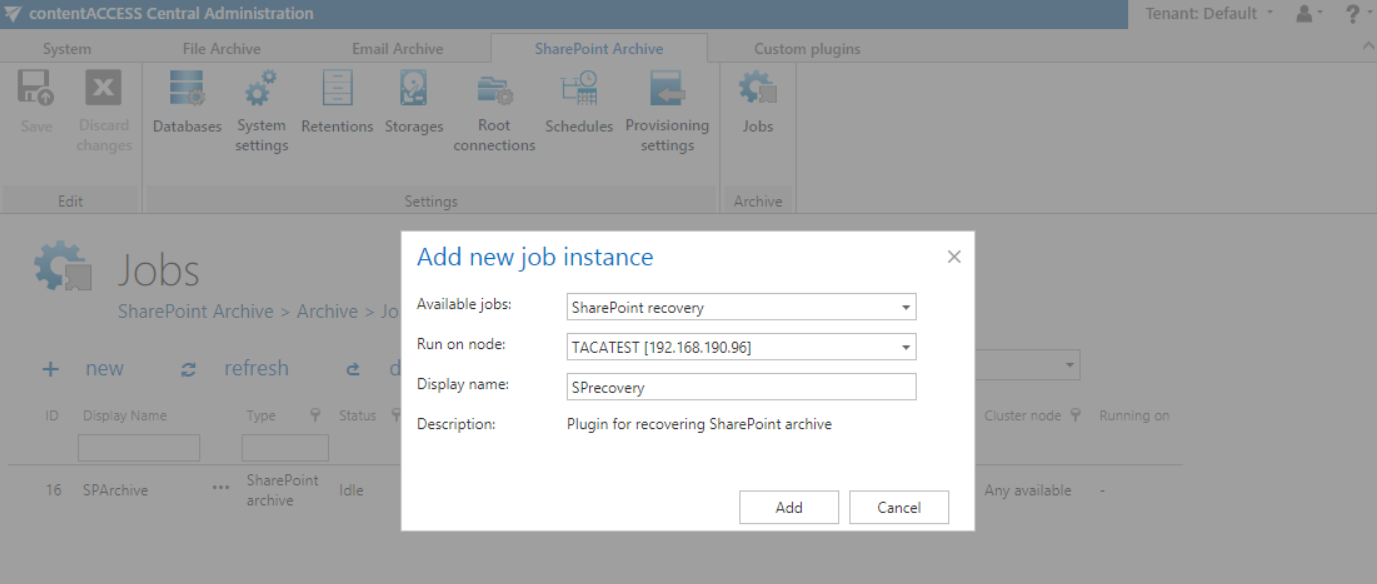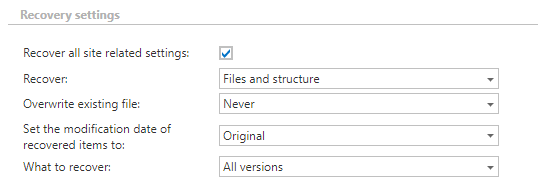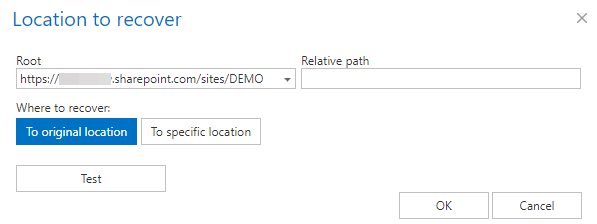
- Introduction to contentACCESS
- contentACCESS setup package
- contentACCESS components
- contentACCESS Tools
- Tenants in contentACCESS
- General system configurations
- Connection
- User interface
- Users in contentACCESS
- Invitations
- Roles
- Login providers
- System
- Licensing
- Notifications
- System logs — how to find out possible misconfigurations / reasons of potential system/job failures
- Configuration auditing
- Archive auditing
- Distributed environment in contentACCESS — Clusters
- Statistics
- Legal hold
- Task runner
- Indexing
- SMTP Servers
- SMTP Mappings
- Sharing job
- Sharing settings
- How to create/configure databases — All databases
- Common features
- Creating new jobs in contentACCESS
- Jobs’ page, jobs’ context menu
- Filtering in jobs
- File Archive
- Introduction to File system archive
- File archive settings
- File archive Databases
- File archive System settings
- File archive Retentions
- File archive Storages
- Root folders
- Aliases
- File archive Schedules
- Provisioning settings and managing access to contentACCESS Portal
- Remote agents (file archive)
- Global rules (remote file archive)
- Configuring aliases
- Configuration of jobs available in contentACCESS File Archive
- Configuration of File archive retention changer job
- Configuration of File system archive job
- Configuration of a File system restore job
- Configuration of File system recovery job
- Configuration of Delete job in File archive
- Configuration of File system shortcut synchronization job
- Configuration of Remote shortcutting job
- Active/inactive documents in File system archive
- Email Archive
- Important settings before creating an Email Archive job
- Database settings
- Email archive System settings
- Email archive Provisioning settings
- Retention settings
- Shortcuts in email archiving
- Storing of archived emails
- Creating email archive schedulers
- User experience
- Address book objects
- Granting access rights for mailbox users and explicit users to view the mailbox archive
- Database and store assignment in email archiving
- Mail app access
- Remote agents (email archive)
- PST import
- Creating Email archive jobs: archive, restore, recovery, delete, mailbox move, shortcut synchronizaion, shortcut repair
- Email archive job
- Email archive retention changer job
- Email restore job
- Email recovery job
- Configuration of Delete job in Email archive
- Journal post processing job
- Mailbox move job
- Shortcut synchronization job
- Shortcut repair job
- Public folder archiving
- Access to private emails and archiving them
- SMTP archiving
- SharePoint archive plugin
- SharePoint Archive settings
- SharePoint Archive job configuration
- SharePoint archive retention changer job configuration
- SharePoint recovery job configuration
- Configuration of Delete job in SharePoint archive
- SharePoint archive Provisioning settings
- SharePoint Publishing job
- SharePoint in the contentACCESS Portal archive
- OneDrive archive
- GDPR plugin
- Teams archive
- Teams archive databases
- Teams archive System settings
- Teams archive Provisioning settings
- Teams archive Address book
- Teams archive Licensing
- Teams archive Jobs
- Custom plugins
- ThreatTest
- officeGATE
- contentACCESS Mobile
- Virtual drive configurations
- Teams application
- Application settings
- Terms of use
- FAQ
- Download sample for the file to be imported does not work
- Archiving is not working if MAPI is set to communicate with the Exchange server
- Virtual drive is still appearing after the uninstall
- Outlook forms problems
- Unable to open shortcuts of archived files on the server side
- Samples are not shown using 'Show sample" option in the Import dialog
- Do I need to create separate tenants for file archiving and email archiving
- What is the recommended database size for email, file and Sharepoint archiving
- The TEMP folder is running out of space when archiving big files
- The attachment could not be opened
- After updating Exchange 2013, the EWS connection might not work in contentACCESS
- If Windows authentication is not working in contentACCESS and an alias was created for contentACCESS
- contentACCESS Outlook add-in certificate issue
- Prerequisites for O365 archiving
- PowerShell scripts for setting up Email archive
- How to reconfigure your email archive to use modern authentication for PowerShell
- Solution for Outlook security patches
- Solution for Outlook security patches through GPO
- Solution for indexing PDF files
- O365 SuperUser mailbox configuration
- Microsoft 365 journaling
- Organizational forms
- Multifactor authentication
- Region setting
- contentACCESS Mail app installation issue
- Azure app registration for O365 archiving
- Troubleshooting
13.4.SharePoint recovery job configuration ↑ Back to Top
SharePoint recovery is used to recover already archived SharePoint items that have been deleted from the original SharePoint location. All items that can be archived by contentACCESS are also recoverable. contentACCESS is able to recover subsites, libraries, and folders, so if they have been deleted, you don’t have to create them manually again for the recovery job to work. It is also able to recover complete sites with their settings if the connection set in the connections to process is a site.
To create a SharePoint recovery job, create a SharePoint recovery job instance first on the SharePoint archive’s Jobs page:

Further, configure this job as follows:
Report mode settings: if the Use report mode checkbox is checked, the job will run in report mode. After the job finishes its run in this mode, the user will be able to download a .csv report file here in this section. The file will contain a list of files/items that belong to the folder(s)/list(s) of the site(s) that is (are) selected in section Connections to process of the job and some information to them, including whether they will be processed or not.

Scheduling settings: in this step the running times of the recovery job must be selected. It is possible either to select a scheduler from the list or to create a new scheduler via create new option. Recovery jobs are run only in specific cases. In most of the cases it is recommended to set a One time scheduler for the recovery job (e.g. with start date 7th of September at 6 PM), or to start the job manually from the status bar. (For more information about how to set schedulers refer to the section Schedules above.)

Recovery settings: in this section, the user configures what will be recovered and how it will be recovered:
-
1. Recover all site related settings – recovers site related settings
- Files and structure – the recovery job will create the archived folder structure and recover the items from the archive
- Structure only – the recovery job will create the archived folder structure, but no items will be recovered
- Never – if the item exists, it will not be processed. Recovery scenarios:
1. If the versioning is enabled on the SP site and we recover all versions => recovers the full version history (missing/deleted items) or just the missing versions (existing items)
2. If the versioning is disabled on the SP site and we recover all versions => recovers only the latest archived version (missing/deleted items) or no action (existing items)
3. If the versioning is enabled on the SP site and we recover last or specific version => recovers the selected version (missing/deleted items) or no action (existing items)
4. If the versioning is disabled on the SP site and we recover last or specific version => recovers the selected version (missing/deleted items) or no action (existing items) - Always – always overwrite existing items with the archived version. Recovery scenarios:
1. If the versioning is enabled and we recover all versions => recovers full version history (missing/deleted items) or just the missing versions (existing items)
2. If the versioning is disabled and we recover all versions => recovers only the latest archived version (missing/deleted or existing items)
3. If the versioning is enabled and we recover last or specific version => recovers the selected version (missing/deleted items) or recover the selected version and this will be the latest version = overwrite the current version (existing items)
4. If the versioning is disabled and we recover last or specific version => recovers the selected version (missing/deleted or existing items) - If older/newer than the archived version – the item will be processed only if its latest version in SharePoint is older/newer than the archived one. Recovery scenarios:
1. If the versioning is enabled and we recover all versions => recovers full version history (missing/deleted items) or just the missing versions (existing items)
2. If the versioning is disabled and we recover all versions => recovers the latest archived version (missing/deleted items) or recovers the latest archived version for the items with the last modified date fulfilling the condition (existing items)
3. If the versioning is enabled and we recover last or specific version => recovers the selected version (missing/deleted items) or recover the selected version of items if their latest version fulfills the condition = will be the latest version (existing items)
4. If the versioning is disabled and we recover last or specific version => recovers the selected version version (missing/deleted items) or recover the selected version for items with the last modified date fulfilling the condition (existing items) - Original – the modification date of the archived item will be set on the recovered file
- Recovery date – the date, when the recovery job is running will be set on the recovered file
- All versions – recover the full version history of items or the missing versions if the items exist
- Last known version – recover the latest archived version of the item if it doesn’t exist in SharePoint
- Specific date – recover the version from the specified (modification) date or before of the item if it does not exist in the SharePoint
2. Recover – what will be recovered
3. Overwrite existing file – when to overwrite the item if it already exists in the target location. The recovery is following the logic depending on the settings:
4. Set the modification date of recovered items to
5. What to recover

Connections to process: in this section the user is required to specify the folder(s) of the site that were deleted and need to be recovered from the archive. Add new connection via New button => the Location to recover dialog will open. First, we select the Root (source) site path from the dropdown list and enter the folder/list to the Relative path text box if necessary. Next, select where the items from the folder/list will be recovered to:
-
To original location – items will be recovered to the place where they were archived from
Click on the To original location button. You can test the accessibility by clicking on the Test button. Click OK.

To specific location – items will be recovered to a different site/folder
Click on the To specific location button. A new dropdown list will appear. Here you can select the destination site for the recovery (it must be also previously configured as Root connection). You can also enter the folder/list to the Relative path text box if necessary. You can test the accessibility by clicking on the Test button – in this case, it checks the accessibility of both locations (the upper “source” and the below “target” location). Click OK.

Notification settings: the user may select here, in which case he needs to get notifications from the recovery job. It is possible to set here that the notification emails will be sent only in case of errors or warnings, or they can be sent in all cases, too. Into the Recipient list textbox, the user should insert the email addresses of the people, to whom these emails should be sent to. Notifications emails may be used as tools of the troubleshooting process.

Resource settings: the number of workers threads running in parallel. Save your settings and wait until the scheduler starts the recovery process (or start it immediately using the status bar).
